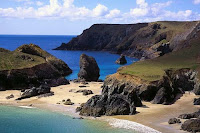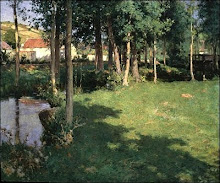To balance the cool colours in the seawater, marine artists often add pink reflections of a sunset, or sunrise. Reddish brown rocks also add contrast. To make a pleasing composition, where there is an area of rocks, or headland, to one side of a painting, a smaller area of rock, or headland, should be added as a counterbalance on the other side. In the painting with the figure, the hair of the woman counterbalances the rocks to some extent.

Frank H. Myers - The Golden Path,
24 x 30 inches, 1940's

USA, 30 x 46 Inches
.+Watercolour+And+Gouache.jpg)
Evening On The Beach.
Dame Laura Knight, R.A. (1877-1970).
Watercolour And Gouache

































.jpg)













+1900.bmp)